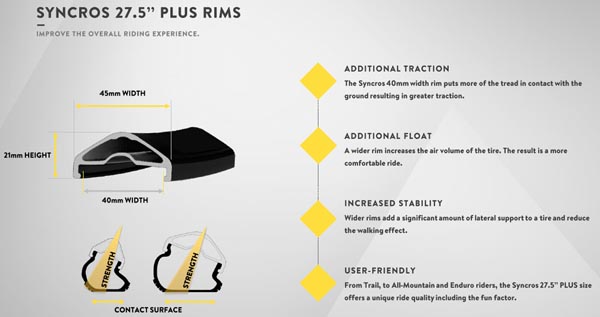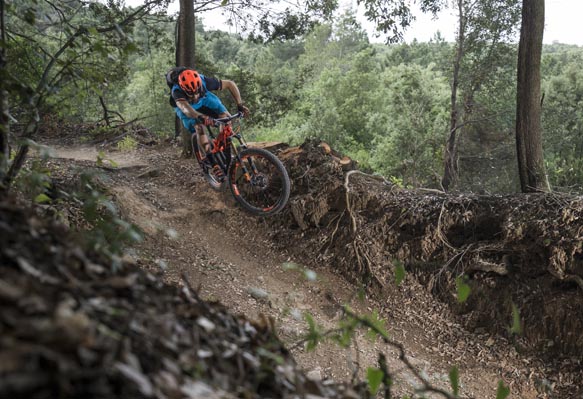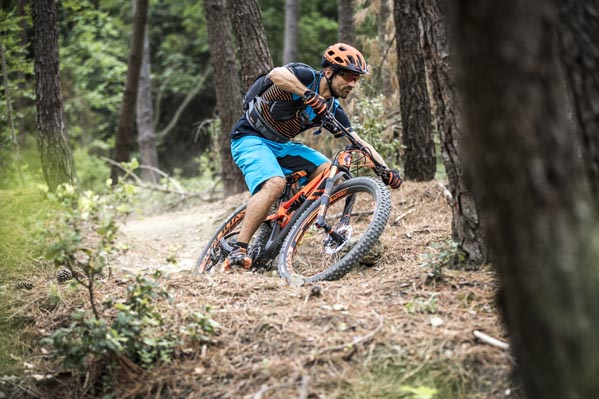Mountain biking is only around 40 years old, so it’s still evolving in all areas. Wheel size alone has been through some dramatic, emotionally charged development in the past five years. With the global growth in popularity of mountain biking over the past decade, it’s become an area of intense and constant focus for brands looking at refining their bikes and parts.

There’s an ongoing battle being waged, mostly between big bicycle brands, who are investing more than ever before in smart engineers to develop mountain bikes to make them more comfortable, better to control and faster.
While it may not be immediately obvious, we, the mountain bikers, are actually the winners in this battle, because we’ve never had so much choice and technology being offered to us as we do now.
Wheel size was largely accepted as being 26-inch for 25 years. Then Gary Fisher revisited the 29er option that had been shelved in the early pioneering days due to lack of tyre availability in that size – off-road 29-inch tyres that is.
His 29-inch wheeled bikes in the early 2000s were largely regarded as quirky, just like Fisher himself; and 29ers remained on the fringe and the domain of small independent brands. However, research by big brands into wheel size began to reveal the undeniable benefits of a bigger wheel. This led to the ‘mainstreaming’ of 29ers and then the introduction – on a mass-market level – of the 27.5-inch wheel, or the 650b as it’s known in Europe. The widely accepted thinking is that 26-inch wheels are for kids, 27.5-inch wheels are for small women and men and gravity-orientated riders; and 29ers are for those seeking stability and performance over longer distances.
It seemed as if that was going to be that, but then fat tyre bikes, not that new, but new to the mainstream market, made a splash in 2014. But the ripples from that splash quickly faded and fat bike remain ideal for riding on sand, snow or by those looking either looking for a bigger challenge (they’re a hard ride), or for attention.
And now, as we move through the middle of 2015 and into 2016 model year line-ups, we see the arrival of the Plus wheel size. Well, the ‘mainstreaming’ of the Plus wheel size, which also isn’t that new (Surley’s Krumpus 29er Plus was launched in 2012).
Plus wheels are generally 27.5-inch in size with wider rims and more chunky tyres, giving them a similar total diameter to 29-inch wheels. So they have the rollover advantage of a bigger wheel. Then there’s the width. By using tyres between 2.8–3.0 inches in width, there’s a larger contact patch with the trail. This translates to greater traction, which in turn translates to greater speed.
The burliness of the tyres also makes line choice less of an issue as they roll over lumps, rocks, roots that you’d normally avoid or ride with caution on a regular 27.5-inch tyre.
According to SCOTT, who collaborated with German tyre brand, Schwalbe on developing the Plus platform for their 2016 Genius model range, there’s a significant increase in traction, a moderate increase in pinch-flat resistance and a fractional increase in rolling resistance, making Plus a no-brainer for trail/all-mountain riding. That’s the theory anyway.


Is it marketing hype?
The cycle industry often gets slated, sometimes rightfully so, for adding new platforms or technology by those claiming that it’s a way to guarantee consistent sales of bikes and parts. Nobody likes to think that the bike he or she just bought will be usurped by next year’s model, available in a few months time.
But, as with electronic goods, bicycles and bicycle parts and accessories are constantly being improved. Some improvements are minor and not worth getting into a state about; others are worth noticing, acknowledging, accepting and, if you’ve got the cash, buying…
SCOTT clearly understands the importance of experience. They spent a heap load of money on two launches, one in Europe in June and one in the USA in July to ensure as many cycling media, SCOTT sales staff and bike shop owners got to ride and feel the Plus size difference.
TREAD was the only South African media invited to attend the US launch. It was held at Deer Valley, Park City, Utah, a mountain bike trail park of significance by any standards. The key was the chairlifts and the high percentage of descending trails. Why? Because that’s where the Plus wheel size benefits would be most noticeable.
Having ridden Fat Bikes for a few months last year, I was skeptical of the Plus platform at first. I really don’t see much value in Fat Bikes other than on lots of sand or snow and when I do see one now, I can still recall the wrist pain I endured from the hard rides on our firm South African trails.
But within the first hour, I went from a Plus size skeptic to a Plus size fan… Why? Why!
Well, I was able to ‘bulldoze’ my way through roots, rocks and ruts with a confidence I haven’t experienced before. The Plus wheels are unashamedly robust and not once on any of those Deer Valley trails (and I rode many of them), did I have to really consider my line choice. Choosing a line that seems the fastest/straightest as opposed to the least likely to destabilise you or damage your tyre/rim, was rather refreshing.
It needs to be said that I did puncture on more than one occasion (pinch flats), but this was on tubed tyres and both times the rear. The test bikes all arrived with tubes and were gradually converted by the mechanics there. No issues on the Plus tubeless tyres to report.
With the wider, larger volume tyre you can run a lower pressure than ‘regular’ tyres. I varied my pressures from 12-15psi (0.8–1.0 bar). I rode the regular Genius LT too, you know, just to be able to draw a comparison between 27.5 and 27.5 Plus. I can’t say I noticed any real difference in rolling resistance on the Plus tyres and average Strava segment times, both taken on the same model Genius, with both tyre platforms, confirm this. On the whole, the Plus was consistently faster – by a few seconds. It varied from 6-8 seconds faster on a 980m long segment that included open an open, straight section followed by a tight and twisty, with drops, roots and a couple of rocks. In other words, pretty balanced in terms of trail obstacles.

But the biggest difference came in the increased traction. Holy cow! It’s so noticeable. On dry, loose turns where I’d normally be wary of my entry speed and line choice, I was able to go in faster and just know that there would traction no matter what angle I needed to lean at. There’s no doubt about it – the Plus platform made me more ambitious.
After some rain, with the trail surface firming up beautifully, there was more a ‘sticky’ traction in turns. So where a regular wheel/tyre would normally start to break away, there was still just a firm grip, allowing me to really attack turns like I’ve never done before. And I’m not afraid of attacking turns.
At my age, I’m wary of doing big jumps in the air, so I started out by squashing most jumps (there are plenty on some of the trails). But repeated runs saw me relaxing my guard and grabbing some air (still not huge air!). This is where I felt just how flickable the Plus bikes were. I followed a former BMX racer (now in his 40s) down one of the big-jump trails and the guy was throwing the Genius Plus around in the air like it was an ice-cream stick!
What about weight? Surely those big tyres add a lot of weight? Not as much as you might think. The Scale 700 Plus hardtails weigh between 11.8-12.5kg, Genius 700 Plus models tip the scales in a range from 12.3-13.8kg; and the Genius 700 LT Plus models are between 12.7–14.0kg. Not much different from regular 27.5-inch trail bikes…
I rode all three models of SCOTT’s Plus series, the Genius 700 Tuned Plus (140mm travel front and 130mm rear); the Genius 700 LT Tuned Plus (160mm travel front and rear) and the Scale 710 Plus, a hardtail with a 120mm travel fork. I was a bit hesitant to try the hardtail because I’ve not ridden a hardtail in ages that’s actually been much different from all the other hardtails. But the Scale Plus is trail-focussed, with a slack headtube angle (67.6 degrees), burly tyres and a medium travel fork. It definitely made an impact on me (full review to follow in an upcoming issue of TREAD). I found myself repeatedly drawn to choosing the Genius 700 LT Tuned Plus when I had the choice of any bike there (and there were many!). It’s a model that will be imported to South Africa (they’d be crazy not too!) and aimed at the Enduro racer/Trail blaster type rider.
SCOTT isn’t the only brand with Plus bikes for 2016. Specialized’s Stumpjumper 6-Fattie (dual sus 27.5) and Trek’s Stache (hardtail 29er) have both been paddling the Plus-size raft in an aggressive sea of consumer cynicism. But SCOTT’s launch of not one, but three categories (a total of eight models) has given the Plus raft a motor…

Will the Plus platform change mountain biking as we know it? Not completely, but it will make a noticeable impact and add depth. I expect that by 2018 all Enduro/Trail/All-mountain bike models from all brands will be Plus-sized.
There will of course be many that shun the arrival of another platform in mountain biking. It’s only natural. We saw it when 29ers first made a mainstream appearance in 2009. Most that shunned 29ers hadn’t yet ridden one. It will be the same with Plus. Ride a Plus bike, before shouting it down. Ride it hard. Then give your opinion – through your broad grin…
TREAD Magazine is sold throughout South Africa and can be found in: Spar, CNA, Exclusive Books, Discerning bike shops and on Zinio
*Originally published in TREAD Issue 36, 2015 – All rights reserved



